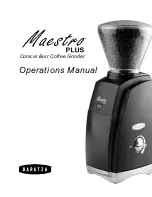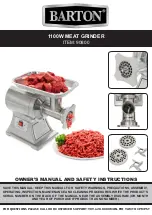
4
Using an extension cable
If an extension cable is required, use and approved extension
cable suitable for the power input of this tool (See technical data).
The minimum conductor size is 1.5 mm
2
.
When using a cable reel, always unwind the cable completely.
Also refer to the table below.
Conductor size (mm
2
) Cable rating (Amperes)
0.75
6
1.00
10
1.50
15
2.50
20
4.00
25
Cable length (m)
7.5
15
25
30
45
60
Voltage
Amperes Cable rating (Amperes)
115
0
-
2.0
6
6
6
6
6
10
2.1 -
3.4
6
6
6
6
15
15
3.5 -
5.0
6
6
10
15
20
20
5.1 -
7.0
10
10
15
20
20
25
7.1 -
12.0
15
15
20
25
25
-
12.1 -
20.0
20
20
25
-
-
-
230
0
-
2.0
6
6
6
6
6
6
2.1 -
3.4
6
6
6
6
6
6
3.5 -
5.0
6
6
6
6
10
15
5.1 -
7.0
10
10
10
10
15
15
7.1 -
12.0
15
15
15
15
20
20
12.1 -
20.0
20
20
20
20
25
-
PERSONAL SAFETY
•
Stay alert, watch what you are doing and use common
sense when operating a power tool. Do not use tool while
tired or under the influence of drugs, alcohol, or medica-
tion.
A moment of inattention while operating power tools may
result in serious personal injury.
•
Dress properly. Do not wear loose clothing or jewelry.
Contain long hair. Keep your hair, clothing, and gloves away
from moving parts.
Loose clothing, jewelry, or long hair can be
caught in moving parts. Air vents often cover moving parts and
should also be avoided.
•
Avoid accidental starting. Be sure switch is off before plug-
ging in.
Carrying tools with your finger on the switch or plugging
in tools that have the switch on invites accidents.
•
Remove adjusting keys or wrenches before turning the tool
on.
A wrench or a key that is left attached to a rotating part of
the tool may result in personal injury.
•
Do not overreach. Keep proper footing and balance at all
times.
Proper footing and balance enables better control of the
tool in unexpected situations.
•
Use safety equipment. Always wear eye protection.
Dust
mask, non-skid safety shoes, hard hat, or hearing protection
must be used for appropriate conditions.
TOOL USE AND CARE
•
Use clamps or other practical way to secure and support
the workpiece to a stable platform.
Holding the work by hand
or against your body is unstable and may lead to loss of control.
•
Do not force tool. Use the correct tool for your application.
The correct tool will do the job better and safer at the rate for
which it is designed.
•
Do not use tool if switch does not turn it on or off.
Any tool
that cannot be controlled with the switch is dangerous and must
be repaired.
E
n
g
li
sh
Summary of Contents for D28803
Page 2: ... ݏ ዐ 13 English 3 Thai 17 ...
Page 18: ...13 English 3 ไทย 17 ...





































